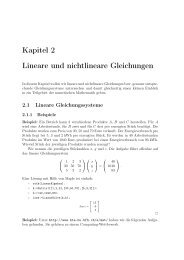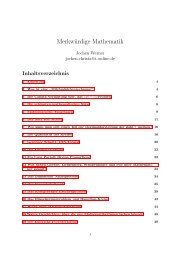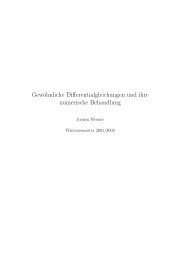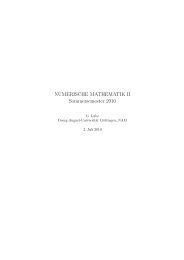BAIL 2006 Book of Abstracts - Institut für Numerische und ...
BAIL 2006 Book of Abstracts - Institut für Numerische und ...
BAIL 2006 Book of Abstracts - Institut für Numerische und ...
Create successful ePaper yourself
Turn your PDF publications into a flip-book with our unique Google optimized e-Paper software.
A.E.P. VELDMANN: High-order symmetry-preserving discretization on strongly<br />
stretched grids<br />
✬<br />
✫<br />
High-order symmetry-preserving discretization on strongly stretched grids<br />
Arthur E.P. Veldman<br />
<strong>Institut</strong>e <strong>of</strong> Mathematics and Computing Science, University <strong>of</strong> Groningen<br />
P.O. Box 800, 9700 AV, Groningen, The Netherlands<br />
Many physical phenomena feature thin bo<strong>und</strong>ary layers, in which the solution varies much more<br />
rapidly than elsewhere in the domain <strong>of</strong> interest. A ‘natural’ approach is to adapt a computational grid<br />
to the variations <strong>of</strong> the solution. In this way one obtains grids with a large diversity in mesh size. Also<br />
the size <strong>of</strong> adjacent mesh cells can be quite different, i.e. the grid shows strong stretching.<br />
‘Traditional’ discretization methods (based on Lagrangian interpolation) focus on minimizing local<br />
truncation error, but experience has shown that these methods prefer low grid stretching rates (e.g. [2]<br />
and the refernces therein). The problems arise because this approach does not take into account the<br />
properties <strong>of</strong> the discrete system matrices that arise after discretization. An alternative approach is to<br />
develop discretization schemes with the properties <strong>of</strong> the system matrix in mind - a general name for<br />
this philosophy is mimetic discretization. Here certain properties <strong>of</strong> the analytic operator are mimiced<br />
in their discrete counterpart.<br />
At RuG we have chosen to retain the symmetry properties <strong>of</strong> the operator, in our application a<br />
combination <strong>of</strong> convection and diffusion. In particular, we discretize convection such that the discrete<br />
version remains skew-symmetric. An almost immediate consequence is that the system matrix remains<br />
diffusively stable (hence never can become singular) on any grid. In formula: Let the system <strong>und</strong>er study<br />
be given by<br />
dφ<br />
+ Lφ = 0,<br />
dt<br />
then the evolution <strong>of</strong> the kinetic energy � φ �H= φ∗Hφ, where H represents the local mesh size, is given<br />
by<br />
d<br />
dt � φ �= −φ∗ ((HL) ∗ + HL)φ.<br />
With skew-symmetric convection, the symmetric part (HL) ∗ + (HL) <strong>of</strong> the system matrix comes only<br />
from diffusion, and the above assertion follows.<br />
Another consequence is that the convective discretization does not produce unphysical numerical diffusion,<br />
which unavoidably will interfere with the physical diffusion. This strategy has been applied e.g.<br />
in direct numerical simulation <strong>of</strong> turbulent flow, where the small-scale balance between convection and<br />
diffusion is quite delicate [3].<br />
In the presentation we would like to illustrate the performance <strong>of</strong> various symmetry-preserving finitevolume<br />
methods: second- and fourth-order central schemes (that we apply in DNS), but also higher-order<br />
upwind schemes. It is less known that on contracting and expanding grids the traditional upwind method<br />
produces negative diffusion [4]; a symmetry-preserving upwind version (a suitable combination <strong>of</strong> skewsymmetric<br />
odd derivatives and symmetric even derivatives) will repair this.<br />
For instance, the fourth-order symmetry-preserving discretization <strong>of</strong> a first-order derivative ∂φ/∂x<br />
becomes<br />
∂φ<br />
∂x ≈ −φi+2 + 8φi+1 − 8φi−1 + φi−2<br />
.<br />
−xi+2 + 8xi+1 − 8xi−1 + xi−2<br />
After muliplication with the denominator (as is usual in a finite-volume setting), the convective contribution<br />
to the coefficient matrix is clearly seen to become skew symmetric.<br />
As a main example we consider a one-dimensional convection-diffusion equation on the unit interval at<br />
a diffusion coefficient k = 0.001. Our ‘favorite’ grid is the Shishkin grid, consisting <strong>of</strong> piecewise-uniform<br />
grid regions with an abrupt (very large) change in mesh size (e.g. [1]). Figure 1 shows a comparison between<br />
the individual solutions <strong>of</strong> second- and fourth-order traditional methods and symmetry-preserving<br />
methods on an abrupt Shishkin grid and on a (smoothly stretched) exponential grid. Both grids contain<br />
Speaker: VELDMANN, A.E.P. 152 <strong>BAIL</strong> <strong>2006</strong><br />
1<br />
✩<br />
✪
















